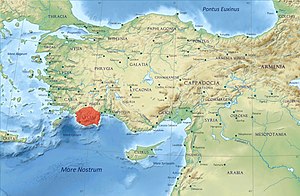Artumpara
 From Wikipedia the free encyclopedia
From Wikipedia the free encyclopedia
Artumpara | |
|---|---|
 Portrait of Artumpara wearing the Achaemenid satrapal headdress, from his coinage. | |
| Allegiance | Achaemenid Empire |
| Years of service | fl. 400 – 370 BC |
| Rank | Dynast of Lycia |

Artumpara, also Arttum̃para, Artembares (Persian name, *Rtambura, self-identified as "the Mede) was an Achaemenid Satrap of Lycia circa 400-370 BCE.[1] He was involved in the Great Satraps' Revolt on the side of central Achaemenid authority in 366-360 BCE, helping to put down the rebel Datames.[2][3] He is well known for his coinage.[4]
Artumpara is known to have competed for power with another man named Mithrapata.[5] It is thought he was defeated by Perikle.[2]
Coinage[edit]
The portrait of Artumpara appears on his coinage, wearing the Achaemenid satrapal headdress.[2]
- Coin of Artumpara, Satrap of Lycia, circa 400-370 BCE.
References[edit]
- ^ Brosius, Maria (2006). The Persians. Routledge. p. 28. ISBN 9781134359844.
- ^ a b c CNG: DYNASTS of LYCIA. Artumpara. Circa 400-370 BC. Stater (Silver, 7.62 g 9), Telmessos.
- ^ Briant, Pierre (2002). From Cyrus to Alexander: A History of the Persian Empire. Eisenbrauns. p. 673. ISBN 9781575061207.
- ^ André-Salvini, Béatrice (2005). Forgotten Empire: The World of Ancient Persia. University of California Press. p. 208. ISBN 9780520247314.
- ^ D. T. Potts, A Companion to the Archaeology of the Ancient Near East (2012), p. 912: "...c. 380–370 BC, two western Lycian dynasts named Arttumpara and Mithrapata claimed power simultaneously."

